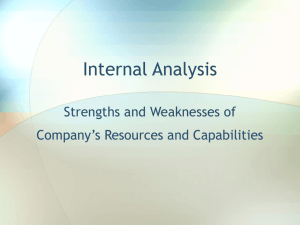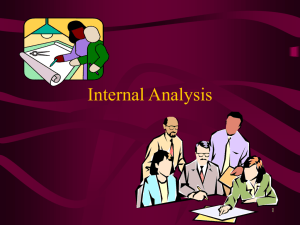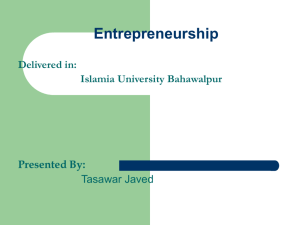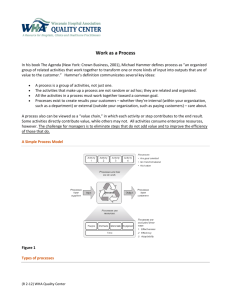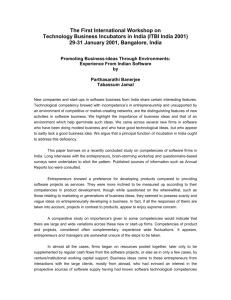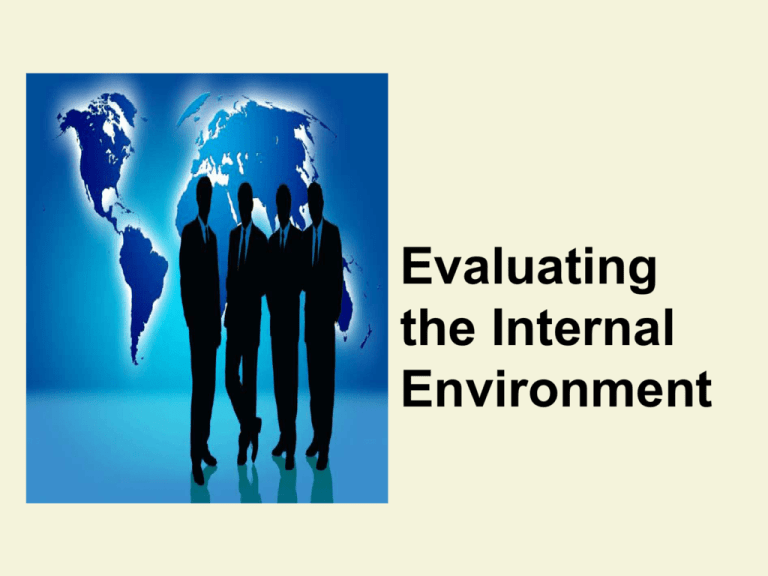
Evaluating
the Internal
Environment
Key Questions in Situation Analysis
• Question 1: How well is the company’s
strategy working?
• Question 2: What are the company’s
resource strengths and weaknesses and its
external opportunities and threats?
• Question 3: Are the company’s prices and
costs competitive?
• Question 4: Is the company competitively
stronger or weaker than key rivals?
• Question 5: What strategic issues and
problems merit front-burner managerial
attention?
Competitive Advantage
• Firms achieve strategic competitiveness and
earn above-average returns when their core
competencies are effectively
Acquired
Bundled
Leveraged
• Over time, the benefits of any value-creating
strategy can be duplicated by competitors
Competitive Advantage (cont’d)
• Sustainability of a competitive advantage is
a function of
The rate of core competence obsolescence due
to environmental changes
The availability of substitutes for the core
competence
The difficulty competitors have in duplicating or
imitating the core competence
Generic Building Blocks of Competitive
Advantage
Outcomes from External and Internal
Environmental Analyses
Examine opportunities
and threats
Examine unique
resources, capabilities,
and competencies
(sustainable competitive
advantage)
The Context of Internal Analysis
• Effective analysis of a firm’s internal
environment (learning what the firm can do )
requires:
Fostering an organizational setting in which
experimentation and learning are expected and
promoted
Using a global mind-set
Thinking of the firm as a bundle of
heterogeneous resources and capabilities that
can be used to create an exclusive market
position
Creating Value
• By exploiting their core competencies or
competitive advantages, firms create value
• Value is measured by
A product’s performance characteristics
The product’s attributes for which customers are
willing to pay
• Firms create value by innovatively bundling
and leveraging their resources and
capabilities
Creating Competitive Advantage
• Core competencies, in combination with
product-market positions, are the firm’s
most important sources of competitive
advantage
• Core competencies of a firm, in addition to
its analysis of its general, industry, and
competitor environments, should drive its
selection of strategies
The Challenge of Internal Analysis
• Strategic decisions in terms of the firm’s
resources, capabilities, and core
competencies
Are non-routine
Have ethical implications
Significantly influence the firm’s ability to earn
above-average returns
The Challenge of Internal Analysis
(cont’d)
• To develop and use core
competencies, managers must
have
Courage
Self-confidence
Integrity
The capacity to deal with uncertainty
and complexity
A willingness to hold people (and
themselves) accountable for their
work
Conditions Affecting Managerial Decisions about
Resources, Capabilities and Core Competencies
Resources, Capabilities and Core Competencies
• Resources
Are the source of a
firm’s capabilities
Are broad in scope
Cover a spectrum of
individual, social and
organizational
phenomena
Alone, do not yield a
competitive advantage
Resources, Capabilities and Core Competencies
• Resources
Are a firm’s assets,
including people and the
value of its brand name
Represent inputs into a
firm’s production
process, such as:
Capital equipment
Skills of employees
Brand names
Financial resources
Talented managers
Resources, Capabilities and Core Competencies
• Resources
Tangible resources
Financial resources
Physical resources
Technological resources
Organizational resources
Intangible resources
Human resources
innovation resources
Reputation resources
Tangible Resources
Financial Resources
• The firm’s borrowing capacity
• The firm’s ability to generate internal
funds
Organizational Resources
• The firm’s formal reporting structure
and its formal planning, controlling,
and coordinating systems
Physical Resources
• Sophistication and location of a firm’s
plant and equipment
• Access to raw materials
Technological Resources
• Stock of technology, such as patents,
trademarks, copyrights, and trade
secrets
Intangible Resources
Human Resources
•
•
•
•
Innovation Resources
• Ideas
• Scientific capabilities
• Capacity to innovate
Reputational Resources
• Reputation with customers
• Brand name
• Perceptions of product quality,
durability, and reliability
• Reputation with suppliers
• For efficient, effective, supportive, and
mutually beneficial interactions and
relationships
Knowledge
Trust
Managerial capabilities
Organizational routines
Resources, Capabilities and Core Competencies
• Capabilities
Are the firm’s capacity to deploy
resources that have been
purposely integrated to achieve
a desired end state
Emerge over time through
complex interactions among
tangible and intangible
resources
Often are based on developing,
carrying and exchanging
information and knowledge
through the firm’s human capital
Resources, Capabilities and Core Competencies
• Capabilities
The foundation of many
capabilities lies in:
The unique skills and
knowledge of a firm’s
employees
The functional expertise of
those employees
Capabilities are often
developed in specific
functional areas or as part
of a functional area
Examples of
Firms’
Capabilities
Copyright © 2004 South-Western. All rights reserved.
3–20
EXAMPLES OF CAPABILITIES
Company
Capability
Result
Logistics -- distributing vast amounts
of goods quickly and efficiently to
remote locations
200,000-percent return to shareholders during first 30 years
since IPO1
An extraordinarily frugal system for
delivering the lowest cost structure in
the mutual fund industry, using both
techno-logical leadership and
economies of scale
25,000-percent return to shareholders during the 30-plus year
tenure of CEO John Connelly.2
As for ongoing expenses, shareholders in Vanguard equity funds
pay, on average, just $30 per
$10,000, vs. a $159 industry
average. With bond funds, the
bite is just $17 per $10,000
Generating new ideas then turning those
ideas into new, profitable products
30 percent of revenue from
products introduced within the
past four years
THE VRINE MODEL
Test
Competitive implication
Performance implication
Valuable? Does the resource or capability allow
the firm to meet a market demand or
protect the firm from market
uncertainties?
If so, it satisfies the value requirement. Valuable resources are
needed just to compete in the industry, but value by itself does not
convey an advantage
Valuable resources and capabilities
convey the potential to achieve
“normal profits” (i.e., profits which
cover the cost of all inputs including
the cost of capital)
Rare?
Assuming the resource or capability is
valuable, is it scarce relative to
demand? Or, is it widely possessed by
most competitors?
Valuable resources which are also
rare convey a competitive advantage, but its relative permanence
is not assured. The advantage is
likely only temporary
A temporary competitive advantage
conveys the potential to achieve above
normal profits, at least until the
competitive advantage is nullified by
other firms
Inimitable
and nonsubstitutable?
Assuming a valuable and rare
resource, how difficult is it for competitors to either imitate the resource
or capability or substitute for it with
other resources and capabilities that
accomplish similar benefits?
Valuable resources and capabilities
which are difficult to imitate or
substitute provide the potential for
sustained competitive advantage
A sustained competitive advantage
conveys the potential to achieve above
normal profits for extended periods of
time (until competitors eventually find
ways to imitate or substitute or the
environment changes in ways that
nullify the value of the resources)
Exploitable?
For each step of the preceding steps
of the VRINE test, can the firm actually
exploit the resources and capabilities
that it owns or controls?
Resources and capabilities that
satisfy the VRINE requirements but
which the firm is unable to exploit
actually result in significant opportunity costs (other firms would likely
pay large sums to purchase the
VRINE resources and capabilities).
Alternatively, exploitability unlocks
the potential competitive and performance implications of the resource
or capability
Firms which control unexploited
VRINE resources and capabilities
generally suffer from lower levels of
financial performance and depressed
market valuations relative to what they
would otherwise enjoy (though not as
depressed as firms lacking resources
and capabilities which do satisfy
VRINE)
Resources, Capabilities and Core Competencies
• Core Competencies
Resources and capabilities
that serve as a source of a
firm’s competitive advantage:
Distinguish a company
competitively and reflect its
personality
Emerge over time through an
organizational process of
accumulating and learning how
to deploy different resources and
capabilities
Resources, Capabilities and Core Competencies
• Core Competencies
Activities that a firm
performs especially well
compared to competitors
Activities through which the
firm adds unique value to its
goods or services over a
long period of time
Building Sustainable Competitive Advantage
• Four Criteria of
Sustainable
Competitive Advantage
Valuable
Rare
Costly to imitate
Nonsubstituable
The Four Criteria of Sustainable Competitive Advantage
Valuable Capabilities
• Help a firm neutralize threats or
exploit opportunities
Rare Capabilities
• Are not possessed by many others
Costly-to-Imitate Capabilities
• Historical: A unique and a valuable
organizational culture or brand name
• Ambiguous cause: The causes and
uses of a competence are unclear
• Social complexity: Interpersonal
relationships, trust, and friendship
among managers, suppliers, and
customers
Nonsubstitutable Capabilities • No strategic equivalent
Building Sustainable Competitive Advantage
• Valuable capabilities
Help a firm neutralize
threats or exploit
opportunities
• Rare capabilities
Are not possessed by
many others
Building Sustainable Competitive Advantage
• Costly-to-Imitate
Capabilities
Historical
A unique and a valuable
organizational culture or
brand name
Ambiguous cause
The causes and uses of a
competence are unclear
(causal ambiguity)
Social complexity
Interpersonal relationships,
trust, and friendship among
managers, suppliers, and
customers
Building Sustainable Competitive Advantage
• Nonsubstitutable
Capabilities
No strategic equivalent
THE VRINE MODEL
Test
Competitive implication
Performance implication
Valuable? Does the resource or capability allow
the firm to meet a market demand or
protect the firm from market
uncertainties?
If so, it satisfies the value requirement. Valuable resources are
needed just to compete in the industry, but value by itself does not
convey an advantage
Valuable resources and capabilities
convey the potential to achieve
“normal profits” (i.e., profits which
cover the cost of all inputs including
the cost of capital)
Rare?
Assuming the resource or capability is
valuable, is it scarce relative to
demand? Or, is it widely possessed by
most competitors?
Valuable resources which are also
rare convey a competitive advantage, but its relative permanence
is not assured. The advantage is
likely only temporary
A temporary competitive advantage
conveys the potential to achieve above
normal profits, at least until the
competitive advantage is nullified by
other firms
Inimitable
and nonsubstitutable?
Assuming a valuable and rare
resource, how difficult is it for competitors to either imitate the resource
or capability or substitute for it with
other resources and capabilities that
accomplish similar benefits?
Valuable resources and capabilities
which are difficult to imitate or
substitute provide the potential for
sustained competitive advantage
A sustained competitive advantage
conveys the potential to achieve above
normal profits for extended periods of
time (until competitors eventually find
ways to imitate or substitute or the
environment changes in ways that
nullify the value of the resources)
Exploitable?
For each step of the preceding steps
of the VRINE test, can the firm actually
exploit the resources and capabilities
that it owns or controls?
Resources and capabilities that
satisfy the VRINE requirements but
which the firm is unable to exploit
actually result in significant opportunity costs (other firms would likely
pay large sums to purchase the
VRINE resources and capabilities).
Alternatively, exploitability unlocks
the potential competitive and performance implications of the resource
or capability
Firms which control unexploited
VRINE resources and capabilities
generally suffer from lower levels of
financial performance and depressed
market valuations relative to what they
would otherwise enjoy (though not as
depressed as firms lacking resources
and capabilities which do satisfy
VRINE)
The Company’s Strengths, Weaknesses,
Opportunities and Threats
• S W O T represents the first letter in
Strengths
Weaknesses
Opportunities
Threats
• For a company’s strategy to be wellconceived, it must be
Matched to its resource strengths
and weaknesses
Aimed at capturing its best market
opportunities and defending against
external threats to its well-being
Identifying Resource Strengths
and Competitive Capabilities
• Common types of resource strengths
include
Skills or specialized expertise in a competitively
important capability
Valuable physical assets
Valuable human assets or intellectual capital
Valuable organizational assets
Valuable intangible assets
Competitively valuable alliances or cooperative
ventures
Identifying Resource Weaknesses
and Competitive Deficiencies
• A weakness is something a firm lacks, does
poorly, or a condition placing it at a
disadvantage in the marketplace
• Resource weaknesses relate to
Inferior or unproven skills,
expertise, or intellectual capital
Deficiencies in competitively important physical,
organizational, or intangible assets
Missing or competitive inferior capabilities in key
areas
Identifying a Company’s
Market Opportunities
• Opportunities most relevant
to a company are those
offering
Good match with its
financial and
organizational resource
capabilities
Best prospects for growth
and profitability
Most potential for
competitive advantage
Identifying External Threats to
Profitability and Competitiveness
• Emergence of cheaper/better
technologies
•
•
•
•
Introduction of better products by rivals
Entry of lower-cost foreign competitors
Onerous regulations
Rise in interest rates
• Potential of a hostile takeover
• Unfavorable demographic shifts
• Adverse shifts in foreign exchange rates
• Political upheaval in a country
Value Chain Analysis
• Allows the firm to understand the parts of its
operations that create value and those that
do not
• A template that firms use to:
Understand their cost position
Identify multiple means that might be used to
facilitate implementation of a chosen businesslevel strategy
Value Chain Analysis (cont’d)
• Primary activities involved with:
A product’s physical creation
A product’s sale and distribution to buyers
The product’s service after the sale
• Support activities
Provide the support necessary for the primary
activities to take place
Value Chain Analysis (cont’d)
• Value chain
Shows how a product moves from raw-material
stage to the final customer
• To be a source of competitive advantage, a
resource or capability must allow the firm:
To perform an activity in a manner that is
superior to the way competitors perform it, or
To perform a value-creating activity that
competitors cannot complete
Service
Marketing and Sales
Procurement
Technological Development
Human Resource Management
Firm Infrastructure
The Basic Value
Chain
Outbound Logistics
Operations
Inbound Logistics
The Value-Creating Potential of Primary
Activities
• Inbound logistics
Activities used to receive, store, and disseminate inputs to
a product (materials handling, warehousing, inventory
control, etc.)
• Operations
Activities necessary to convert the inputs provided by
inbound logistics into final product form (machining,
packaging, assembly, etc.)
• Outbound logistics
Activities involved with collecting, storing, and physically
distributing the product to customers (finished goods
warehousing, order processing, etc.)
The Value-Creating Potential of Primary
Activities (cont’d)
• Marketing and sales
Activities completed to provide means through which
customers can purchase products and to induce them to
do so (advertising, promotion, distribution channels, etc.)
• Service
Activities designed to enhance or maintain a product’s
value (repair, training, adjustment, etc.)
Each activity should be examined relative to
competitors’ abilities and rated as superior,
equivalent or inferior
The Value-Creating Potential of Primary
Activities: Support
• Procurement
Activities completed to purchase the inputs needed to
produce a firm’s products (raw materials and supplies,
machines, laboratory equipment, etc.)
• Technological development
Activities completed to improve a firm’s product and the
processes used to manufacture it (process equipment,
basic research, product design, etc)
• Human resource management
Activities involved with recruiting, hiring, training,
developing, and compensating all personnel
The Value-Creating Potential of Primary
Activities: Support (cont’d)
• Firm infrastructure
Activities that support the work of the entire value chain
(general management, planning, finance, accounting, legal,
government relations, etc.)
Effectively and consistently identify external opportunities and
threats
Identify resources and capabilities
Support core competencies
Each activity should be examined relative
to competitors’ abilities and rated as
superior, equivalent or inferior
Selected difference between
Southwest and large Airlines
Southwest
Major Airlines
Technology
and design
• Single aircraft
• Multiple types of
Operations
• Short segment flights
• Smaller markets and secondary
aircrafts
airports in major markets
• No baggage transfers to others
airlines
• No meals
• Single class of service
• No seat assignments
Marketing
• Limited use of travel agents
• Word of mouth
• Hub and spoke
system
• Meals
• Seat assignments
• Multiple classes of
service
• Baggage transfer to
other airlines
• Extensive use of
travel agents
Southwest made
choices so that
competitors did not
copy - because
copying would
require them to
abandon activities
essential to their
strategies
Outsourcing
• The purchase of a value-creating activity
from an external supplier
Few organizations possess the resources and
capabilities required to achieve competitive
superiority in all primary and support activities
• By forming and emphasizing fewer
capabilities
A firm can concentrate on those areas in which it
can create value
Specialty suppliers can perform outsourced
capabilities more efficiently
Service
Marketing and Sales
Procurement
Technological Development
Outsourced
activity
Firm Infrastructure
A firm may
outsource all or only
part of one or more
primary and/or
support activities.
Human Resource Management
Outsourcing Decisions
Outbound Logistics
Operations
Inbound Logistics
Strategic Rationales for Outsourcing
• Improve business focus
Lets a company focus on broader business
issues by having outside experts handle various
operational details
• Provide access to world-class capabilities
The specialized resources of outsourcing
providers makes world-class capabilities
available to firms in a wide range of applications
Strategic Rationales for Outsourcing (cont’d)
• Accelerate business re-engineering benefits
Achieves re-engineering benefits more quickly
by having outsiders—who have already achieved
world-class standards—take over process
• Sharing risks
Reduces investment requirements and makes
firm more flexible, dynamic and better able to
adapt to changing opportunities
• Frees resources for other purposes
Redirects efforts from non-core activities toward
those that serve customers more effectively
Outsourcing Issues
• Greatest value
Outsource only to firms possessing a core
competence in terms of performing the primary
or supporting the outsourced activity
• Evaluating resources and capabilities
Do not outsource activities in which the firm
itself can create and capture value
• Environmental threats and ongoing tasks
Do not outsource primary and support activities
that are used to neutralize environmental threats
or to complete necessary ongoing organizational
tasks
Outsourcing Issues (cont’d)
• Nonstrategic team of resources
Do not outsource capabilities that are critical to
the firm’s success, even though the capabilities
are not actual sources of competitive advantage
• Firm’s knowledge base
Do not outsource activities that stimulate the
development of new capabilities and
competencies
Cautions and Reminders
• Never take for granted that core competencies will
continue to provide a source of competitive
advantage
• All core competencies have the potential to become
core rigidities
• Core rigidities are former core competencies that
now generate inertia and stifle innovation
• Determining what the firm can do through
continuous and effective analyses of its internal
environment increases the likelihood of long-term
competitive success
Cautions and Reminders (cont’d)
• Determining what the firm can do through
continuous and effective analyses of its
internal environment increase the likelihood
of long-term competitive success

